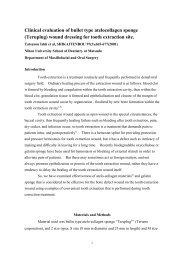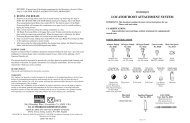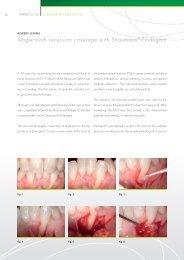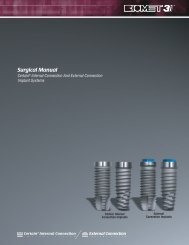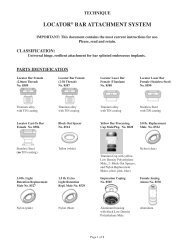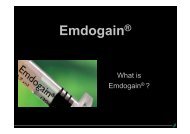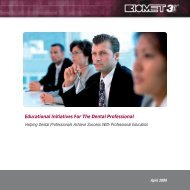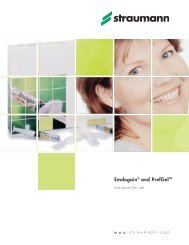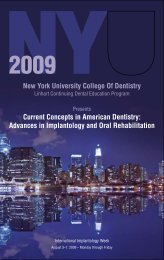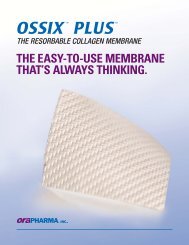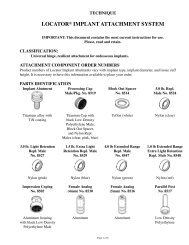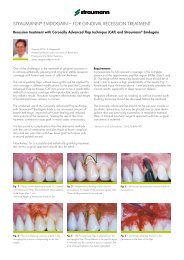Research Dossier
Research Dossier
Research Dossier
- No tags were found...
You also want an ePaper? Increase the reach of your titles
YUMPU automatically turns print PDFs into web optimized ePapers that Google loves.
Discrete Calcium Phosphate Nanocrystals EnhanceOsteoconduction On Titanium-based Implant SurfacesVanessa C. Mendes, John E. Davies, Institute of Biomaterials and Biomedical Engineering, Faculty of Dentistry,University of Toronto, OntarioCanadian Biomaterials Society25th Annual Meeting(May 26–28, 2006, Calgary, Alberta, Canada)IntroductionContact osteogenesis, or the apparent growth of bone on (oralong) an implant surface, is the result of bothosteoconduction, which we have defined as the “recruitmentand migration of osteogenic cells”, and the subsequentsecretory activities of these migrated cells which results inthe elaborated bone matrix. The surface microtopography ofimplants has been demonstrated to influence biologicalresponse in the peri-implant compartment and, specifically,to enhance early peri-implant healing and promote increasedbone-implant contact when compared to smooth surfaces. 1,2,3These mechanisms have now been thoroughly documented. 4,5We have previously described a bone-ingrowth chambermodel to quantitatively measure osteoconduction, normallyreferred to as Bone Implant Contact (BIC). 2 However, withoutfurther refinements of the model, we have not, until now,employed this method to compare osteoconduction onmetallic surfaces of essentially similar microtopography. Wedescribe herein, the detailed design of, and refinements to,this miniature bone ingrowth chamber model; the processingtechniques we have developed to derive histological data frommultiple samples in parallel; the block face preparation andback-scattered electron imaging techniques we employ toderive multiple planes of examination from each multiplesample group; and the means of quantitatively analyzing theexperimental results.modified before assembly. On one external surface, a notchwas laser-etched in an angle of 45°, to enable calculation ofthe height of each cross section of the chamber duringsample analysis. All implants were dual-acid-etched (DAE)using either H 2 SO 4 /HCl or HCl/HF for cp and alloy implantsrespectively. Half of the cp and alloy implants were modifiedby the CaP/DCD (nominal crystal size 20nm; surface coverageapprox. 50%; modified particulate sol-gel deposition method).Thus, a total of four groups: cp, cpDCD, alloy and alloyDCDwere generated. Four groups of 25 Tplants of eachexperimental group (total=100), were placed anteroposteriorlyinto the distal metaphyses of both femora of maleWistar rats for nine days (Figure 2). After harvesting,individual samples (Figure 3) were mounted in groups of 10on custom plate holders (Figure 4) and resin embedded forblock-face microscopy (Figure 5). The block surface wasrepeatedly ground (automated polishing machine, EcoMet3000 & AutoMet 200 Power Head, Buehler, IL, USA) toproduce back-scattered electron images (BSEI), followingplatinum sputter coating, of different planes of the implantchamber (Figures 6 and 7). Quantitative analysis of BIC wasperformed with the software Sigma Scan Pro 4 (SPSS Inc.)on >450 micrographs. Single and multiple analysis of variance(ANOVA) were applied to bone contact measurements as afunction of metal (cp vs. alloy) and modification with CaP. Allstatistical analysis were conducted using JMP v5.0.1 software(SAS Institute, Inc., Cary, NC). Statistical significance wasconsidered at p < 0.05 and a Tukey-Kramer HSD post hocanalysis was applied to mean comparisons where indicatedby an overall statistical influence.Our results show that etched titanium alloy is moreosteoconductive than commercially pure titanium. Whenmodified by nano-scale deposits of calcium phosphatecrystals, osteoconduction on both metals is furthersignificantly increased.Materials And MethodsCustom designed T-shaped implants (“Tplants”), 5 x 3 x2mm, were fabricated by BIOMET 3i in Palm Beach Gardens,Florida, USA, from either commercially pure (“cp”) or titaniumalloy (Ti6Al4V or “alloy”). The stem of the “T” is hollow witha cavity 3x2x1mm into which bone could grow followingimplantation (Figure 1). The Tplants are constructed inmodular parts so that their inner walls can be surfaceFigure 1Figure 3Figure 2Figure 413



